Guavas are evergreen shrubs or small trees in the Myrtaceae family grown for their edible fruits. The trunk of the Guava is slender, and its bark is smooth and green to red-brown. This plant produces a green or yellow oval-shaped fruit. Numerous yellowish seeds are inside the flesh, which can be white, yellow, pink, or red. Common Guava may also be called Guava, and its origin is unknown, although it grows in parts of tropical America.
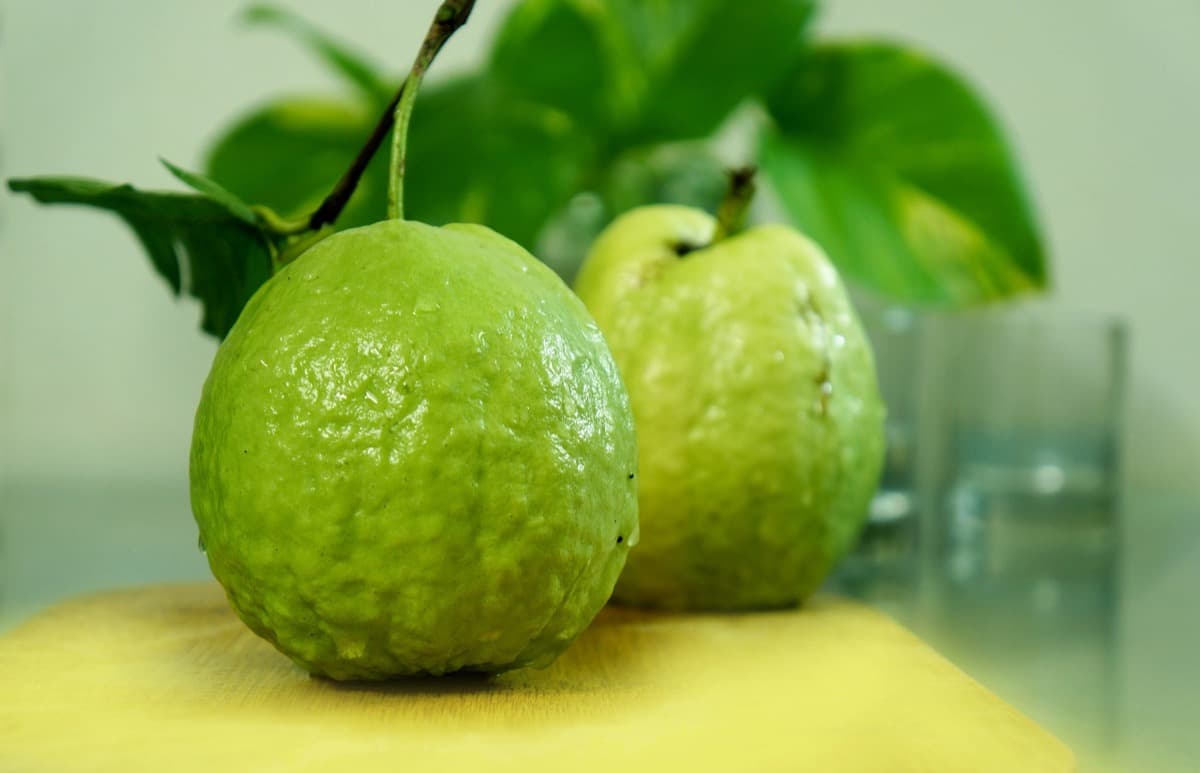
Plants of Guava were brought to India by the Portuguese in the 17th century. Later, it spread to other locations. After mango, banana, and citrus, it is India’s fourth most important crop. There are many places in India where it can be grown. Guava is cultivated in Bihar, Uttar Pradesh, Maharashtra, Karnataka, Orissa, West Bengal, AP, and Tamilnadu. Additionally, it can be grown successfully in Punjab, Haryana, and Uttar Pradesh.
VNR Guava farming
VNR guava
VNR Bihi is an innovative guava variety developed through research. VNR Nursery, a private research organization in the horticulture sector, developed the variety. The VNR Bihi is the largest Guava in India. All aspects of it are unique. A guava VNR is a tropical fruit similar to a pear with a green rind and pinkish or white flesh and small seeds.
Depending on the species, the fruit is usually round or oval, ranging in size from 4 to 12 cm. It might be rough on the outside, bitter, or soft and sweet on the inside. Generally, the skin is green when young but turns yellow, maroon, or green as it matures, depending on the species. Fruits of the guava plant generally have a pronounced and characteristic fragrance. There are varying numbers and hardness of seeds in the central pulp of guavas, which may be sweet or sour, off-white to deep pink.
VNR guava characteristics
- Big size attractive fruit
- Average Fruit size–300 — 1000 grams per fruit
- Uniform & appealing fruit color
- Less seed cavity area and a very thick Pericarp
- Early fruiting variety harvesting is suggested from 2nd year onwards
- Prolific bearer variety and suitable for all types of soil
- Staggered harvesting as fruit can stay up for 10-12 days in the plant
- Suitable for long-distance transport
- Longer shelf life of 15 days–if stored in refrigerated condition can stay up to 30 days
- Good balance of acid and sugar
- Maximum profitability
VNR Guava cultivating states information
VNR Guava is currently being exported to over 30 countries worldwide. Major guava-producing countries include India, Brazil, South Africa, Jamaica, Egypt, and Thailand, among many others. In India, major guava-producing states include Maharashtra, Bihar, Andhra Pradesh, Uttar Pradesh, Rajasthan, Karnataka, Gujrat, Uttar Pradesh, and Tamil Nadu. Out of all the states, Maharashtra is the leading producer of VNR Guava both quantity-wise and area.
Soil requirements for VNR guava cultivation
Guava is important because it is a hardy plant that can be grown on various soils, including shallow, medium black, and alkaline soil. However, it grows successfully on well-drained soils with at least 0.5 to 1m depth. The soils should not be deep, marshy, or low-lying, with a hard pan or water table in the root zones. Soils with a pH between 4.5 and 8.2 are suitable for cultivating VNR Guava.
In case you missed it: How to Start Hybrid Guava Farming in India: Varieties, Business Plan, and Cultivation Management
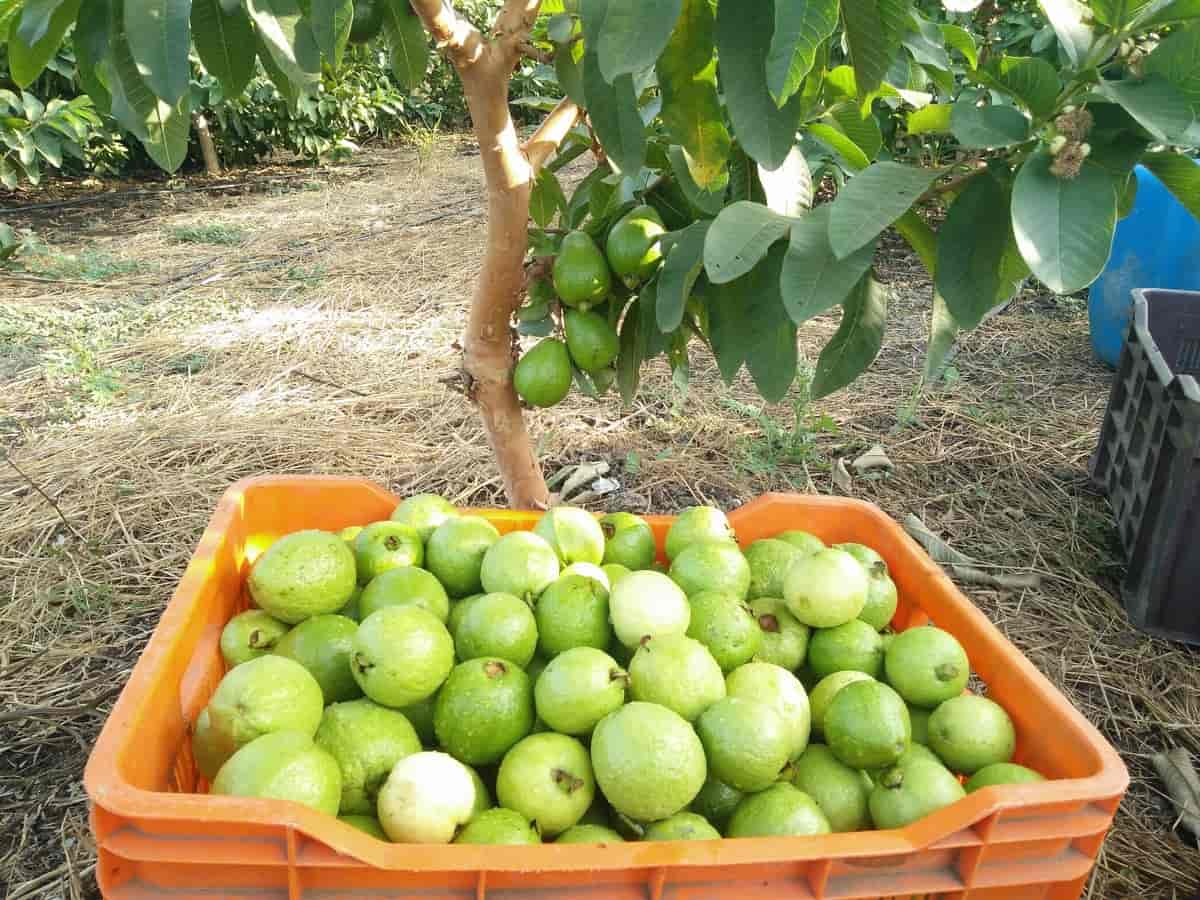
Agro-climatic requirements
Guava is grown in both tropical and sub-tropical regions up to 1,500 m. above m.s.l. It tolerates high temperatures and drought conditions in north India in the summer. However, it is susceptible to severe frost as it can kill young plants. Annual rainfall of about 100 cm. is sufficient during the rainy season (July-September). Rainfall during the harvesting period deteriorates the quality of fruits.
Spacing and time of sowing
The plants are usually planted at a distance of 5-8 m. However, the exact planting distance is decided according to soil fertility and the availability of irrigation facilities. Standard spacing is 6 m. x 6 m. accommodating 112 plants/acre. By increasing the plant density, productivity can be increased. In the model scheme, a spacing of 6 m. x 6 m. with a population of 110 plants per acre has been considered, which was commonly observed in areas where this guava variety is cultivated.
High-density planting causes erect growth of branches, making the plant tall and compact, and giving a higher yield/unit area in early fruiting years. Therefore, February-March or August-September month is the optimum time for planting Guava.
Propagation VNR guava
Air layering or stooling procedure has been popular as the easiest and most affordable way to propagate guava plants. However, growing guava plants from seeds are challenging and result in poor fruit quality and yield. All you have to do to make your vegetative propagation truly productive is make the appropriate choice of plants that produce high-quality fruits that help propagate new plants having the attributes of the mother plant.
Choose branches of a pencil diameter that are not near any joining parts. Cut a 2-inch length of branch skin and peel it off. Apply a rooting substance like NAA 500 PPM or IBA 500 PPM to the peeled area. Wrap it with a polythene sheet after covering it with moist moss. It is important to keep both ends open. Roots will grow from the cutting branch after 20-25 days. The best time to layer is from July to September.
Land preparation and planting
Plowing, leveling, and weeding should prepare the land during the dry days. Dig pits measuring 1mx1mx1m before the monsoon begins. Fill each hole with 25 kg of farmyard manure, 500 grams of SSP, 15 kg of Neem cake, 50 grams of Lindane powder, and soil for fertilization to prevent termite invasion. Showing should be done between August and September to achieve optimal results. (February and March are also chosen for planting).
Maintain a sowing depth of 25-30 cm. Put a tree stake in place before planting. Drive the stake into the ground to the side of the hole at least 2 feet deep. Set the plant in the hole so that the soil mark from the nursery pot on the stem is at the surface level of the surrounding soil. Spread the roots out in all directions.
Re-fill the hole with half native soil and half aged compost or commercial organic planting mix; firm in the soil so that there are no air pockets among the roots. Water in the soil and create a modest soil basin around the trunk to hold water at watering time. Secure the tree to the stake with tree ties. After planting, thoroughly water each tree and fertilize it with a high-phosphorus starter fertilizer.
VNR Guava tree flowering and pollination
- Guava trees bloom in early spring but may bloom all year round in mild climates.
- There are male and female parts in each flower of the guava tree.
- Honeybees pollinate guava flowers.
- If you don’t have bees, you can hand-pollinate the flowers.
- Use a very small paintbrush to ensure the flowers are tickled from the inside.
- Before flowering, spray your guava trees with a 5 % urea solution mixed with a wetting agent.
- The plant should be watered after the urea spray has dried. The fruit will be produced for a longer period as a result.
In case you missed it: How to Control Pests and Diseases in Guava: Causes, Symptoms, Chemical, and Biological Management
Irrigation requirements for VNR Guava cultivation
The majority of VNR Guava is grown under rainfed conditions. Irrigation is provided for 20-25 days during the winter season. The ring method lasts 10-15 days during the summer months. The use of drip irrigation has proven to be very beneficial for Guava. It saves about 60% of the water used for irrigation. In addition, the size and number of fruits have increased substantially. Guavas prefer deep root watering during the dry season, allowing the soil to dry a bit between waterings.
Water regularly during the growing season, and reduce watering during the winter. For fungi prevention, apply water at the tree’s base to avoid getting the foliage wet. A guava tree’s mature branches produce larger fruits. Therefore, regularly watering the tree will promote branch growth. In addition, flowering is a time to avoid flood irrigation since it leads to excess flower dropping.
Fertilizer requirement in VNR Guava cultivation
Inorganic fertilizers and organic manure are quite beneficial for guava cultivation. The fertilizer application in VNR Guava is as follows,
| Age of crop(Year) | Well-decomposed cow dung (in kg) | Urea(in gm) | SSP(in gm) | MOP(in gm) |
| First to three year | 10-20 | 150-200 | 500-1500 | 100-400 |
| Four to six-year | 25-40 | 300-600 | 1500-2000 | 600-1000 |
| Seven to ten year | 40-50 | 750-1000 | 2000-2500 | 1100-1500 |
| Ten years and above | 50 | 1000 | 2500 | 1500 |
Spray the trees with 0.34 kg slaked lime and 0.45 kg ZnSO4 (Zinc Sulfate) dissolved in 16 gallons (72.74 l) of water if the trees are deficient in zinc. Determine how many sprays to use based on the degree of the deficit. Apply pre-flowering sprays of 0.3 percent ZnSO4 and 0.4 percent Boric Acid to your guava crop to boost fruit size and yield.
Pruning and training
Pruning and training are key to producing guava plants with resilient frameworks capable of producing higher yields. Pruning should be practiced regularly to remove dead, diseased, and infected branches. Pruning during summer should be avoided to prevent sunburn on budding plants. Rather than allowing guava seedlings to stand upright with their strong stems, provide them with the necessary support when they grow.
Weeding work on Guava farm
- Normally weeding has to be done every three months on the guava farm so that guava trees get maximum nutrients from the soil and the land is clear.
- We can use hand labor to do the weeding work. But it will be time-consuming and more e time using expensive.
- Normally do a weeding for the 1-acre farm. We need ten hand laborers, which will take at least seven days to complete.
- We can complete the job in two days if we use a mini tractor with a rotavator attachment
- A rotavator is a machine that cuts pulverized mixes and levels soil on farms
- Guava trees thrive in this soil because it improves drainage, levels the area, and makes the ground perfect.
- The use of a rotavator will also reduce fuel consumption and time spent on the job
- During March, July, and September, spray plants with Gramoxone at 5ml/liter of water per acre to prevent weed growth. One acre of land can be sprayed with 200 liters.
In case you missed it: How this Farmer Earning 60 Lakh Rupees from Thaiwan Pink Guava Cultivation
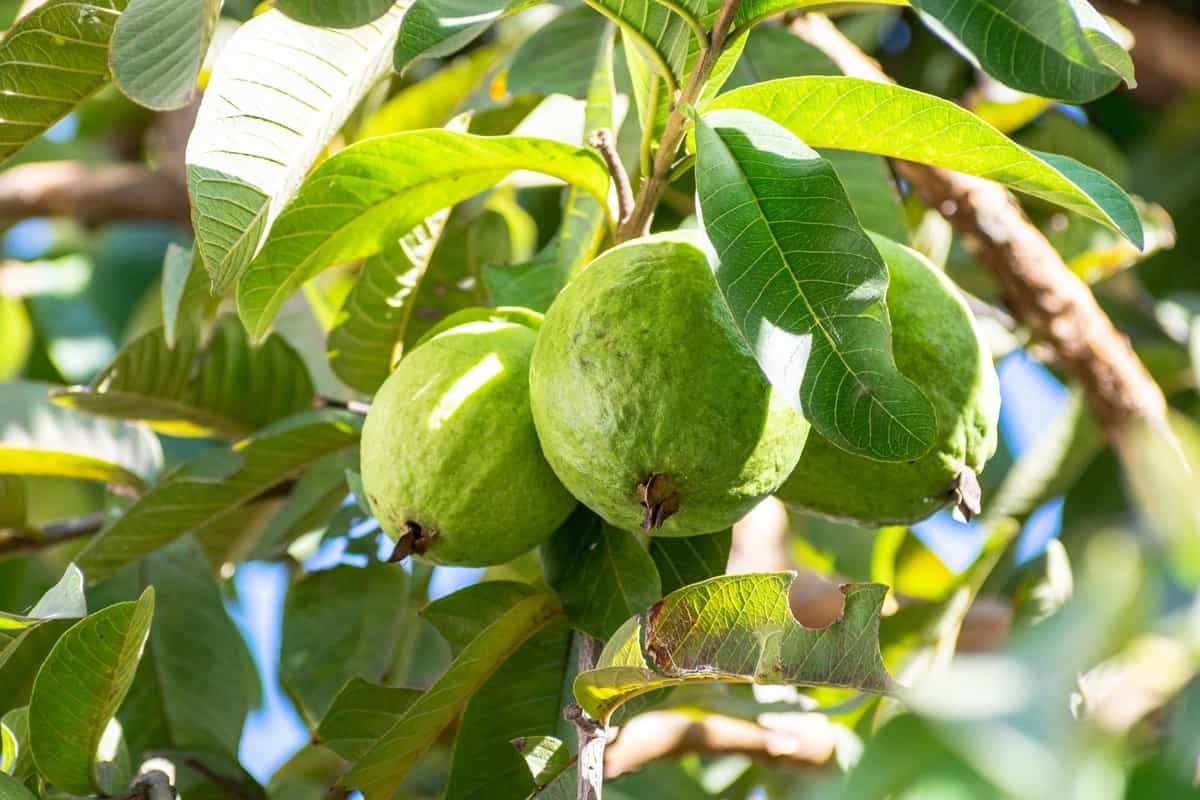
Maintenance of the plantation
Establishing a plantation is not finished once it has been established. The plantation must be protected from weather, fire, insects, fungi, and animals, for example. Various cultural treatments may also be required to achieve the plantation’s goals. For the Guava plant to grow, it needs full sun to part shade. It cannot, however, withstand too much heat. It is very difficult for guava plants to tolerate cold temperatures. The mature tree will lose all its leaves in the winter, while the young may die from frost damage. From the beginning of spring, new leaves begin to grow.
Major pests in Guava
Guava fruit borers
Damage symptoms
- Caterpillar/larva bores into young fruits.
- Feeding on internal contents (pulp and seeds) makes the fruit hollow.
- Fruit rotting and dropping
Control methods
- Insecticides: malathion 50 EC 0.1% two rounds, one at flower formation and next at fruit set
- Predators: Chrysoperla, Rove beetles, Spiders, Coccinellids, Robber flies, Dragonfly, Reduviid bugs, Praying mantes, Fire ants, Big-eyed bugs, Pentatomid bugs, Earwigs, Ground beetles, common mynah, King crow.
Castor capsule borer
Damage symptoms
- Stem dries up as larva bores into it and then damages capsules.
- Infected fruits dry up and fall off without ripening
- The affected fruits are generally deformed at the point of entry of larvae.
- Larvae feces may be seen exuding out of the borer hole. Such fruits weaken, rot and dropdown.
Control methods
- Collect and destroy the damaged plant parts.
- Use a light trap 1/ha to monitor the activity of adults.
- Spray malathion 50 EC at 3 L or endosulfan 3 L or dimethoate 30 EC 3 L in 1500 – 2000 L water per ha, two rounds, one at flower formation and the next at the fruit.
Bark-eating caterpillar
Damage symptoms
- The infestation of the pest may be identified by the presence of irregular tunnels and patches covered with a silken web consisting of excreta and chewed-up wood particles on the shoots, branches, stem, and main trunk.
- Holes on the trunk, wood dust, and fecal matter hang in the form of a web around the affected portion.
- The stem can die if severe damage is sustained. New webbing can be seen beneath the blackish larva.
- The joints of the shoots and branches may also show shelter holes.
- Young shoots dry out and die off, giving the plant a sickly appearance
Control methods
- The basal portion of the trunk should be sprayed with Coal Tar + Kerosene at 1:2 or Carbaryl 50 WP 20 g / l of water.
- A cotton pad soaked in monocrotophos 36 WSC 10 ml in 2.5 cm /tree is used as the padding.
- Monocrotophos 36 WSC 10 to 20 ml/hole after application
- For each hole, one aluminum phosphide tablet (3 g aluminum phosphide) is used
- Put 5 g of carbofuran 3G in each hole and plug it with mud.
In case you missed it: A Guide to Understand Guava Plant/Tree Propagation: Check How this Guide Helps Guava Farmers
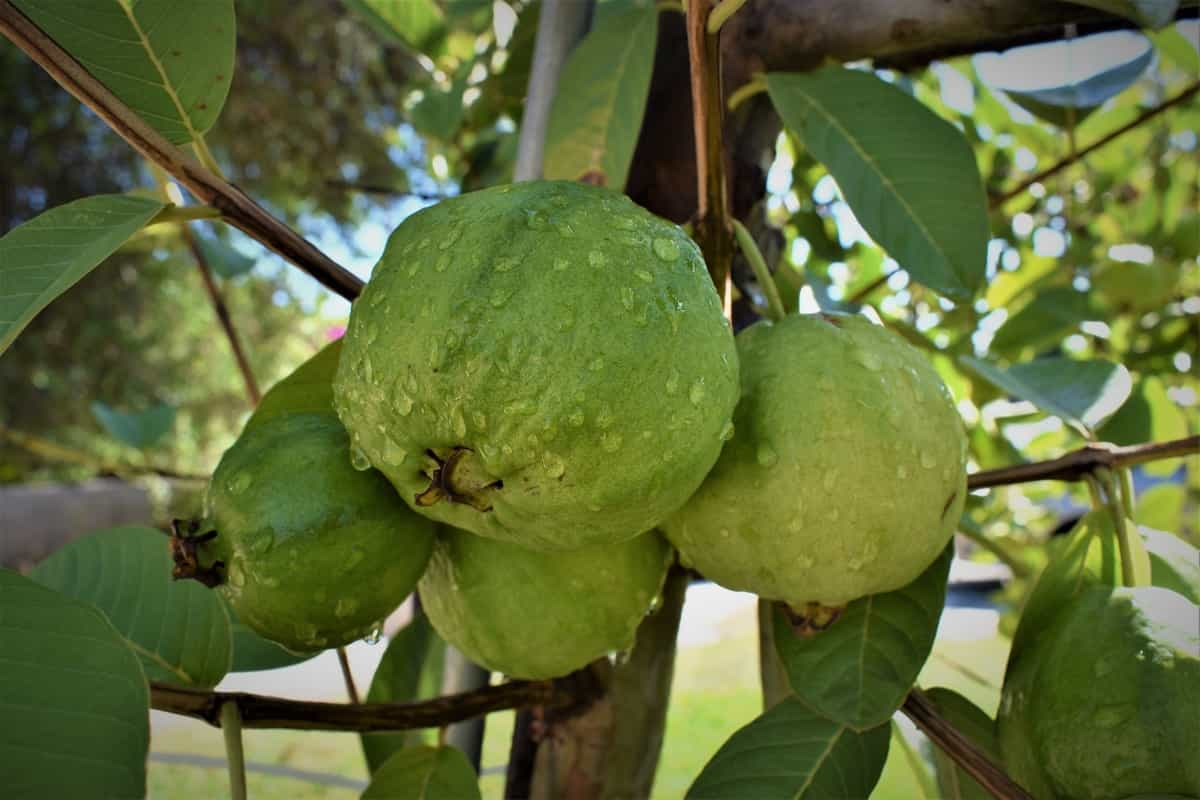
Major diseases in Guava
Algal leaf spot
Damage symptoms
- Symptoms of the disease are orange, rust-colored, dense silky tufts ranging from 5 to 8 mm in diameter on both abaxial and adaxial leaf surfaces.
- As the spots are scraped off, a thin crust of grayish-white to dark-colored necrotic material remains.
- It is common for these spots to form large irregular patches on a leaf. A dull, grayish-green color develops as the spots mature.
Chemical control and management
- Algal leaf spots can be reduced with cultural practices such as fertilization, irrigation, pruning, weed management, and wider spacing of trees.
- A tree’s vigor and susceptibility to this disease can be improved by managing insect, mite, and other foliar diseases.
- Spray Copper oxychloride 0.25%.
Guava rust
Disease symptoms
- The pathogen can be affected by guava foliage, young shoots, inflorescences, and fruit.
- The symptoms of this disease include distortion, defoliation, reduced growth, and, if severe, death.
- A dark-bordered, roughly circular brown lesion with yellow halos appears on fully expanded leaves
Chemical control and management
- The use of fungicides is the most effective method of controlling guava rust.
- For fungicide application to be timely and effective, it is recommended to scout fields for the onset of disease or during periods of favorable environmental conditions for pathogen infection.
- Also, fertilization, irrigation, pruning, and sanitation aid in achieving healthy, vigorously growing trees less susceptible to disease.
Fruit Canker
Disease symptoms
- Initially, minute, brown, or rust-colored, unbroken, circular, necrotic areas appear on fruits.
- The margin of the lesion is elevated, and a depressed area is noticeable inside. The crater-like appearance is more noticeable on fruits than on leaves.
- In severe cases, raised, cankerous spots develop in great numbers, and the fruits break open to expose seeds
- Infected fruits remain underdeveloped, become hard, malformed, and mummified and drop. Sometimes, small rusty brown angular spots appear on the leaves.
Chemical control and management:
- 1% Bordeaux mixture or lime-sulfur (1in 25) – 3 or 4 sprayings.
- PH wash with aureofungin (200ppm) can protect fruits for five days.
- The fruit rot can be checked by dip treatment of the fruits with aretan.
Harvesting of VNR Guavas
Approximately 120 and 150 days after pruning the Guava trees, the fruit will be ripe and ready for harvest. The Guava tree can produce two crops yearly in warm climates, a large crop in summer and a smaller crop in winter. During the ripening process, guava fruits develop mature light green colors; these fruits cannot be maintained on the tree longer. Therefore, fruit should be picked as soon as they reach maturity.
In case you missed it: A Step-By-Step Guide to High Density Fruit Farming: For Guava, Banana, Mango, Pineapple, Lemon, Papaya, Litchi, and Apple
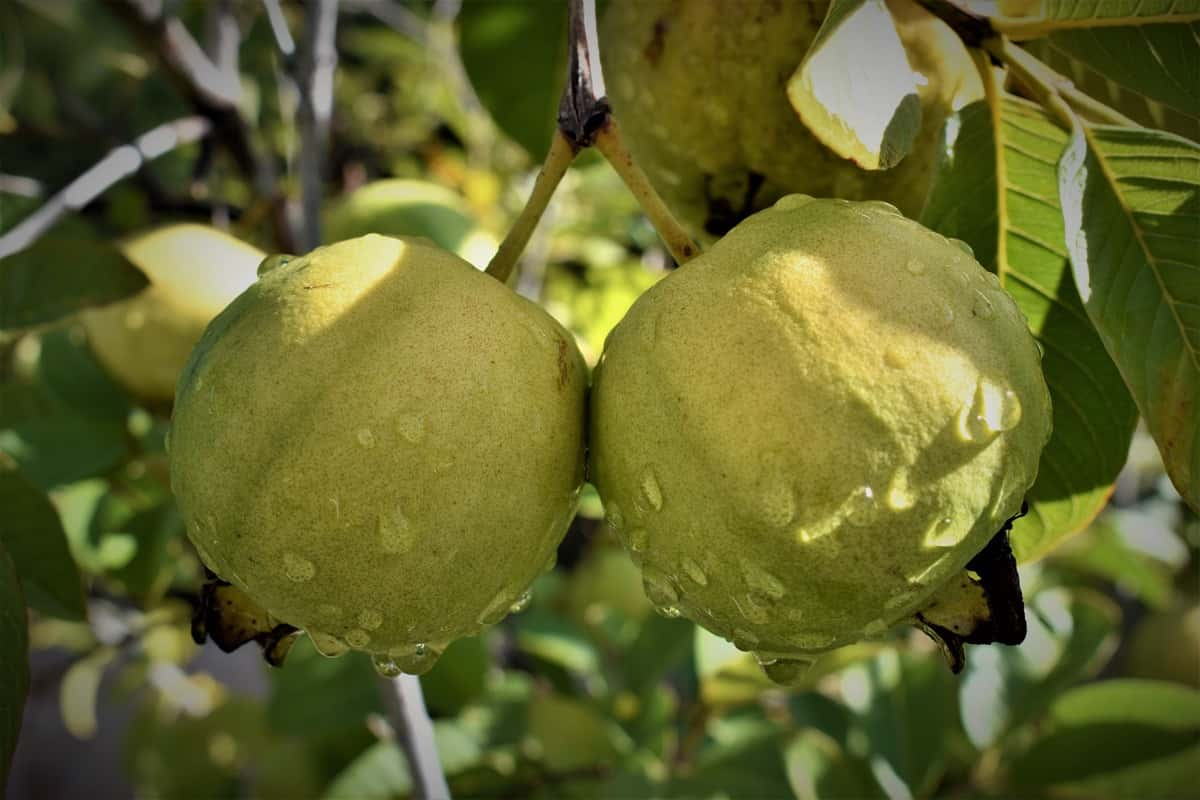
The change can determine their tender age in color from green to light yellowish green. It is possible to harvest fruits in several ways. One can first hand-pick fruits at intervals of a few days by hand. Fruit plucking machines are also available in the market for harvesting fruits. Several factors affect the yield of this fruit crop, including plant age, soil fertility, soil type, irrigation frequency, and pest and disease control. A grafted tree can yield up to 350 kg per tree, while a seedling plant can yield up to 90-150 kg or 6 tons per acre.
Conclusion
Many states in India grow VNR guava, from Jammu to Tamilnadu and Assam to Gujarat. The plant can grow successfully in tropical & sub-tropical climates as well as in humid or dry climates and is highly drought-resistant but susceptible to frost. As a result, it produces a higher quality crop in areas that have a distinct dry & moderate winter. Maharashtra, Madhya Pradesh, and Bihar are the top three states that produce Guava in India.
- Types of Pesticides Used in Agriculture: A Beginner’s Guide
- Economical Aquaculture: A Guide to Low-Budget Fish Farming
- 15 Common Planting Errors That Can Doom Your Fruit Trees
- How to Make Houseplants Bushy: Effective Tips and Ideas
- Innovative Strategies for Boosting Coconut Pollination and Yield
- Pollination Strategies for Maximum Pumpkin Yield
- The Complete Guide to Chicken Fattening: Strategies for Maximum Growth
- Natural Solutions for Tulip Problems: 100% Effective Remedies for Leaf and Bulb-Related Issues
- Revolutionizing Citrus Preservation: Towards a Healthier, Greener Future
- Natural Solutions for Peony Leaf and Flower Problems: 100% Effective Remedies
- Maximizing Profits with Avocado Contract Farming in India: A Comprehensive Guide
- Natural Solutions for Hydrangea Problems: 100% Effective Remedies for Leaf and Flowers
- The Ultimate Guide to Choosing the Perfect Foliage Friend: Bringing Life Indoors
- From Sunlight to Sustainability: 15 Ways to Use Solar Technology in Agriculture
- The Ultimate Guide to Dong Tao Chicken: Exploring from History to Raising
- The Eco-Friendly Makeover: How to Convert Your Unused Swimming Pool into a Fish Pond
- Mastering the Art of Delaware Chicken Farming: Essentials for Healthy Backyard Flocks
- 20 Best Homemade Fertilizers for Money Plant: DIY Recipes and Application Methods
- How to Craft a Comprehensive Free-Range Chicken Farming Business Plan
- Brighten Your Flock: Raising Easter Egger Chickens for Beauty and Bounty
- How to Optimize Your Poultry Egg Farm Business Plan with These Strategies
- Subsidy for Spirulina Cultivation: How Indian Government Schemes Encouraging Spirulina Farmers
- Ultimate Guide to Raising Dominique Chickens: Breeding, Feeding, Egg-Production, and Care
- Mastering the Art of Raising Jersey Giant Chickens: Care, Feeding, and More
- Ultimate Guide to Raising Legbar Chickens: Breeding, Farming Practices, Diet, Egg-Production
- How to Raise Welsummer Chickens: A Comprehensive Guide for Beginners
- How to Protect Indoor Plants in Winter: A Comprehensive Guide
- Ultimate Guide to Grow Bag Gardening: Tips, Tricks, and Planting Ideas for Urban Gardeners
- Guide to Lotus Cultivation: How to Propagate, Plant, Grow, Care, Cost, and Profit
- Agriculture Drone Subsidy Scheme: Government Kisan Subsidy, License, and How to Apply Online
- Ultimate Guide to Raising Araucana Chickens: Breed Profile, Farming Economics, Diet, and Care
- Bringing Hydroponics to Classroom: Importance, Benefits of Learning for School Students
- Ultimate Guide to Raising Polish Chickens: Breed Profile, Farming Economics, Diet, and Care
- Ultimate Guide to Raising Australorp Chickens: Profile, Farming Economics, Egg Production, Diet, and Care
- Silkie Chicken Farming: Raising Practices, Varieties, Egg Production, Diet, and Care
- Sussex Chicken Farming: Raising Practices, Varieties, Egg Production, Diet and Care
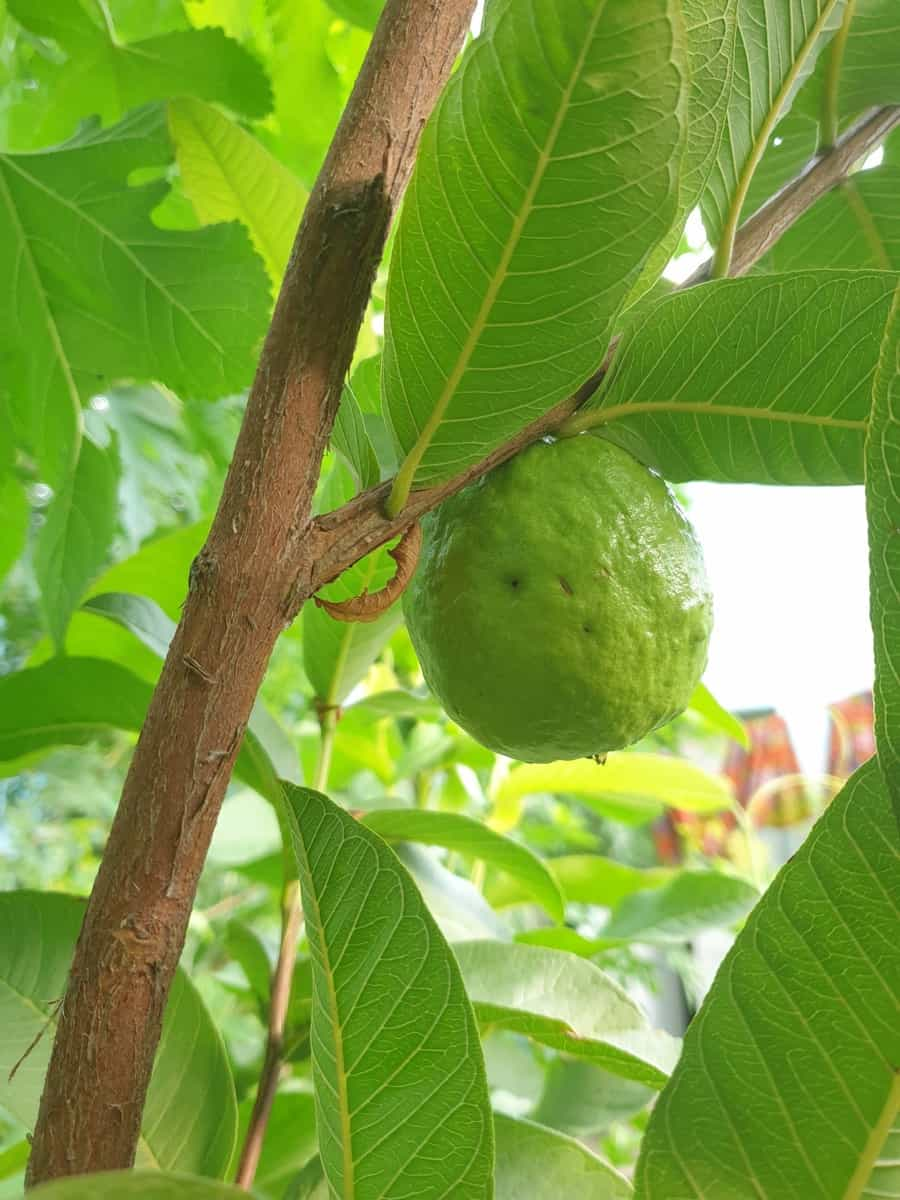
My Guava plant leaves are getting brown at the edges & having brown spots on leaves. Please can you suggest treatment. The edge of plant is 3 years.